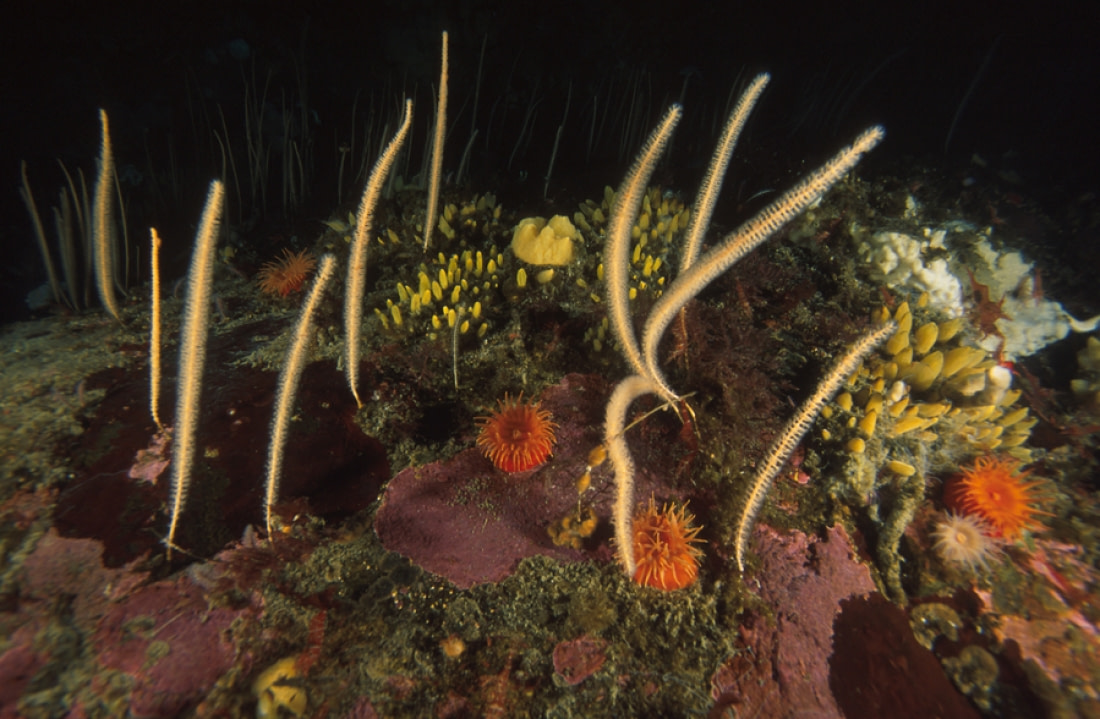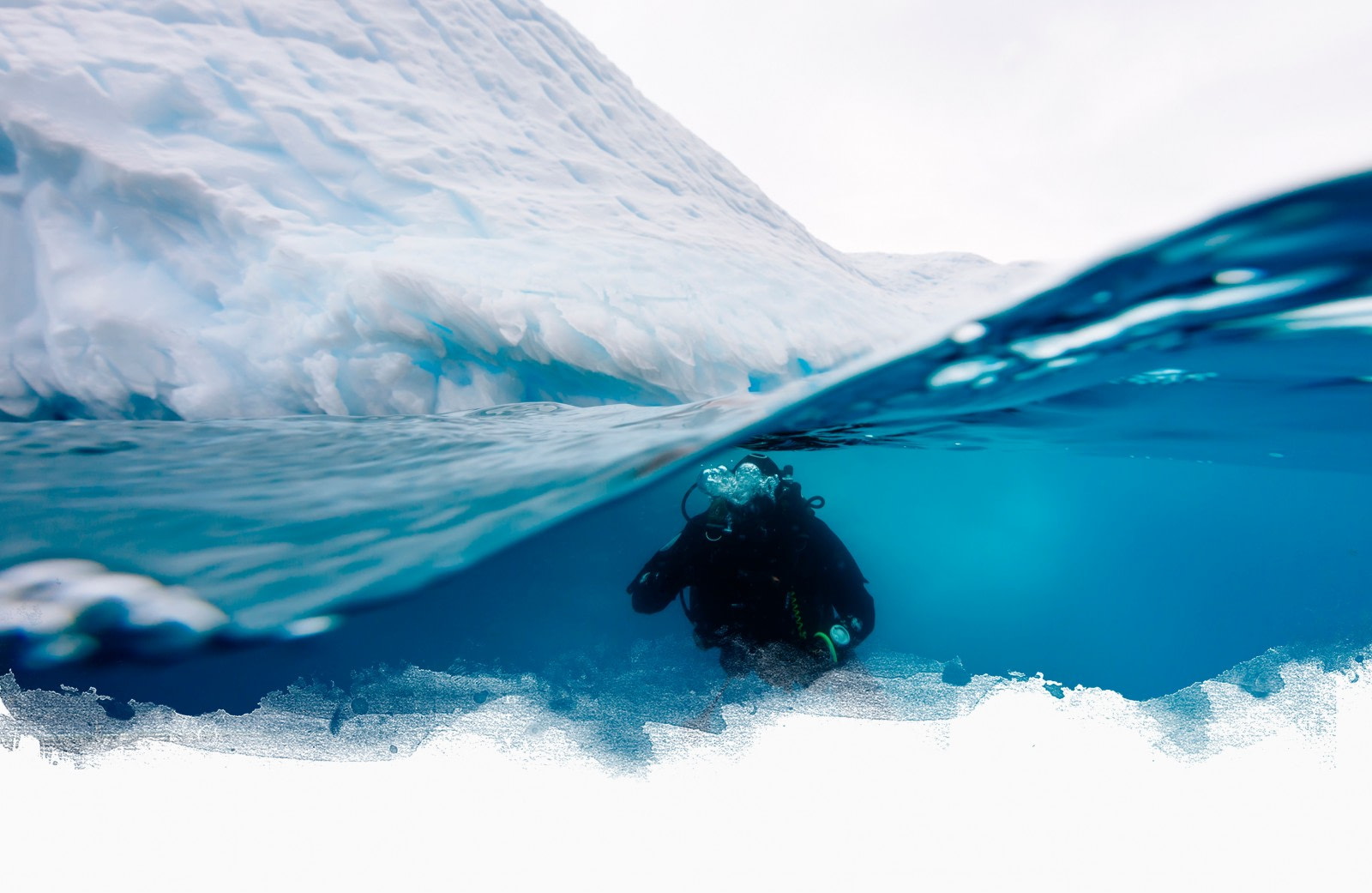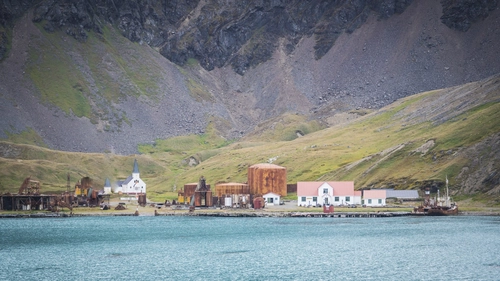Scuba Diving Trips in Antarctica and the Arctic
Our polar voyages provide maximum firsthand contact with local wildlife and terrain, as well as unparalleled adventures below the waves.
Join us on one of our Arctic or Antarctic diving cruises for access to some of the most scenic dive sites in the polar regions.
Explore the underbellies of icebergs, encounter exotic marine life, and enjoy the interplay of ice, light, and water in a rarely seen world.
Our dives and itineraries are based on the extensive experience of our international guides.
When you dive with us, you get the best polar adventure in the most capable hands.

General Information on Our Diving Activity
- Divers must be experienced with cold-water, dry-suit diving.
- We aim for one to two dives per day (morning and afternoon).
- Diving depends on local ice and weather conditions.
- All dive guides are certified experts.
- We offer basic equipment on board, but divers must bring personal gear.
- We make dives from our Zodiac boats.
- Maximum dive depth is around 20 meters / 65 feet.
- We may observe various marine life in both Antarctica and the Arctic.
- Details on booking this activity can be found on our Dates & Rates webpage.
Arctic Dive Program
(Spitsbergen & Greenland)
Encounter iconic wildlife and explore beautiful ice formations that distinguish this region from Antarctica.
We make shallow dives near or under ice floes (about nine meters deep) and deeper shoreline dives (nine to 18 meters deep).
In the Arctic, we may encounter seals, sea lions, and walruses. We may observe them underwater using snorkels and masks, but we cannot dive with walruses due to safety concerns.
Antarctic Dive Program
(Antarctic Peninsula, Falkland Islands, & South Georgia)
Explore dazzling icecaps, colossal glaciers, and towering mountains, as well as white-sand beaches and lush flora of the sub-Antarctic islands.
We dive from our Zodiacs, exploring ice walls, marine life, and sometimes shipwrecks at shallow depths (around 20 meters / 65 feet).
You may observe penguins, fur seals, and leopard seals. Many sub-Antarctic islands are rich with krill, a prime food source for marine species.
Weather in the Polar Regions
Arctic voyages are during the Northern Hemisphere summer (May to September) with milder weather. The sun shines 24 hours a day, and temperatures range from 5 to 15°C (41 to 59°F).
In Antarctica's Southern Hemisphere summer (December to February), temperatures are close to freezing, varying between -5 to 8°C (23 to 46°F). Strong katabatic winds can make it feel even colder.
Warm and waterproof clothing is required for both regions. Severe weather may lead to the cancellation of landings and dives, as excursions can only take place in safe conditions.
Program Changes Due to Weather and Ice
We know our dive destinations well and are always exploring new sites. However, nature dictates our schedule. Local ice, weather, or wildlife may force changes in our itinerary. We always have planned alternatives, but they are not grounds for reimbursement.
Dive Experience and Qualifications
Our polar dive voyages are for experienced divers familiar with cold-water, dry-suit diving. You must have logged at least 30 dry-suit dives to participate.
Before departure, present an internationally accepted diving certificate and logbook. The first dive of our voyage will be a “check dive†to try out your gear and ensure you have enough experience to participate. If any diver does not meet the necessary experience, they may be excluded from the dive program without reimbursement.
All divers must follow the instructions of dive leaders and guides at all times and participate at their own risk.
Expedition Team, Excursions, & Dive Leaders
Our expedition team consists of an expedition leader and multiple guide-lecturers experienced in the polar wilderness. Each morning, you will be informed of the day's program, and excursions will be evaluated in the afternoon and after dinner.
Occasionally, the team will organize lectures supported by slide shows to inform passengers about the polar environment. Our dive leaders are highly experienced instructors assisted by one or two dive guides. The main language of all guides and dive operations is English.
Special Note: Safety First
Diving in the polar regions is no more dangerous than normal scuba diving if you follow the rule: safety first. There are no decompression chambers, medical care is limited, and infrastructure is minimal. We have a doctor on board for first-aid assistance, but we cannot accept risky ventures from any divers.
Dive Procedures
Approach to Dive Site: Normally, six divers per Zodiac with one driver-guide. Watch your gear when embarking and disembarking. Oceanwide is not liable for the loss of equipment.
Check Dive: The voyage starts with a check dive to get used to the cold water, try out equipment, and determine weights needed. Briefings are held before each dive.
Currents: Water currents can be present anywhere. Dive guides will select safe spots and give information on returning to the Zodiacs if needed.
Dive Buddy: Dives use the buddy system. Dive guides stay on the surface for safety. Divers are expected to read their compasses and depth gauges and look after each other.
Dive Guide-to-Diver Ratio: Six divers per guide, with a maximum of 24 diving passengers per voyage. Larger groups may need to split activities and reduce the number of dives.
Drifting Pack Ice: This is a hazard. We only dive around icebergs that are hard aground or floating in clear water.
Equipment: Every diver prepares their own equipment in advance. Bring spare parts for regulators and dry suits. Set up and carry your equipment in and out of the Zodiac.
Number of Dives: We plan for one to two dives per day, but exact numbers depend on ice and weather conditions.
Visibility: Ample pack ice often means flat water with clear visibility. Little pack ice can mean plankton blooms and swells. Ice and weather conditions vary each year.
Dive Equipment
Bring the following equipment yourself:
- Dry suit with hood
- Two sets of warm underwater garments
- Dry gloves or wet gloves/mitts for sub-zero waters
- Two freeze-protected regulators
- Stabilizing jacket or BC with sufficient lift capacity
- Pressure gauge
- Compass watch
- Knife and torch
- Mask, fins, and snorkel








Eight Ultimate Antarctica Adventures

The Classic Polar Cruise: Antarctic Peninsula Facts, Pics, and More

A Diving Dream Fulfilled

Wreck Diving in Antarctica

Diving in Antarctica: The Ultimate Underwater Experience

Day and night in Antarctica

Why a Polar Diving Cruise Should be Your Next Great Decision






 23 Days / 22 Nights
23 Days / 22 Nights


